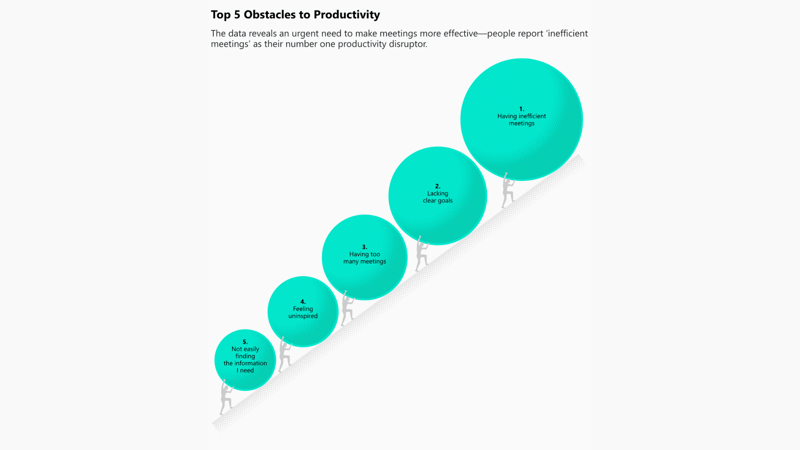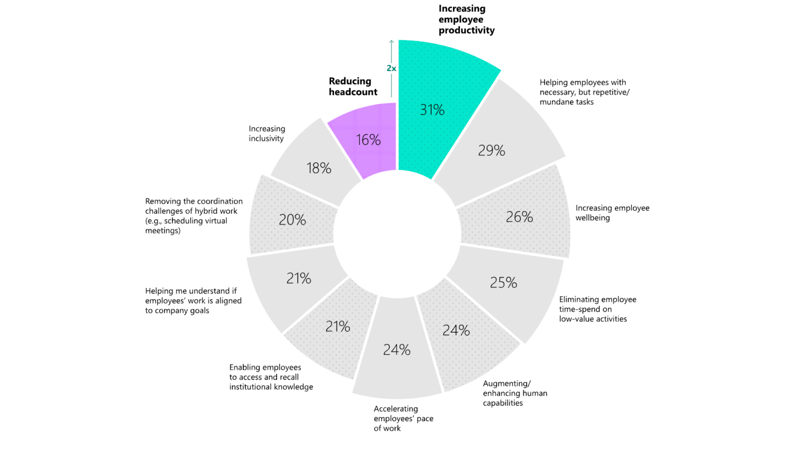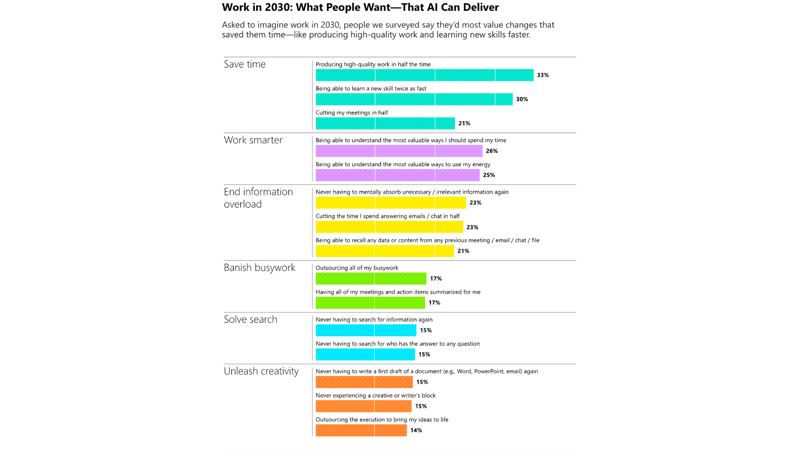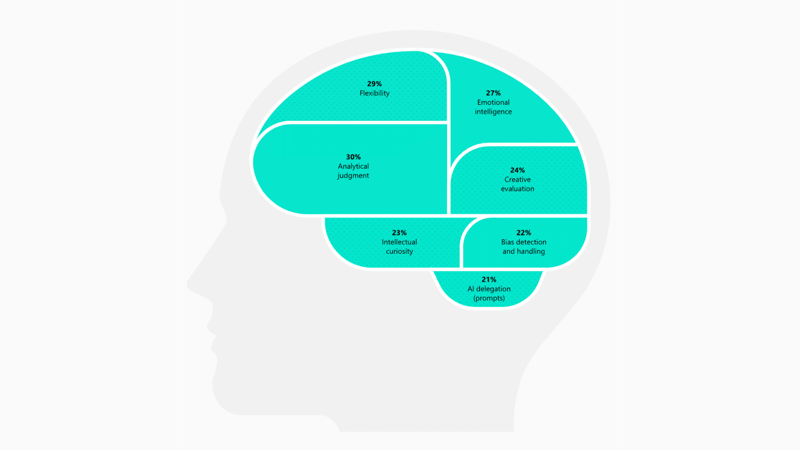
The transition to AI is accelerating, poised to revolutionise the future of work. Many are eagerly awaiting this change, as the pace of work has surged alongside an overwhelming influx of data and constant communication. Individuals are grappling with this information overload, while business leaders face pressure to boost productivity in uncertain economic times.
AI luckily offers a solution to this challenge. Traditionally, AI has operated in a passive mode, but the emergence of next-generation AI , copilot promises to transform the landscape. These advanced tools will work collaboratively with people, alleviating digital debt and fostering innovation. Businesses that leverage AI effectively will uncover new levels of creativity and productivity, driving a new era of growth and value creative tasks more.
Satya Nadella, Chairman and CEO of Microsoft, emphasises this potential: “This new generation of AI will remove the drudgery of work and unleash creativity. There’s an enormous opportunity for AI-powered tools to help alleviate digital debt, build AI aptitude, and empower employees.”
To prepare leaders and businesses for the AI-driven future, Microsoft surveyed 31,000 individuals across 31 countries and analysed trillions of Microsoft 365 productivity signals, along with labor trends from the LinkedIn Economic Graph. Their findings highlight three critical insights that business leaders must consider to adopt AI swiftly and responsibly.
.png?width=800&height=450&name=Three%20Findings%20(Website).png)
1. Digital debt is costing us innovation
We’re all burdened with digital debt: the relentless piles of data, emails, meetings, and notifications is surpassing our capacity to process it. The pace of work continues to accelerate, making it challenging to keep up. With everything seeming urgent, we spend our workdays just trying to stay afloat. Nearly 64% of people report struggling with having enough time and energy to perform their jobs effectively—and those individuals are 3.5 times more likely to encounter difficulties with innovation and strategic thinking. Additionally, 60% of leaders are already feeling the strain, with a notable concern over the lack of innovation and breakthrough ideas within their teams.
This digital debt is not only impacting individual productivity but also stifling creativity, which is crucial for driving innovation. For instance, in areas like Medical Training and 3D Visualisation managing digital clutter could hinder advancements in training methodologies and visual tech integrations.
With only so many minutes in the day, every moment spent managing digital debt detracts from the time needed for creative endeavours that drive innovation. In today’s landscape, where creativity is the key to productivity, digital debt is more than a mere inconvenience—it’s a significant impediment to business progress, including advancements in Engineering and Microsoft Teams.
.png?width=800&height=450&name=Workday%20(Website).png)
"68% of people say they don’t have enough uninterrupted focus time during the workday."
Hours worked, workday span, and time spent in meetings have steadily increased over the past few years—making communication easier than ever while simultaneously making it harder to keep up. A closer examination of how people allocate their time reveals significant opportunity costs due to a lack of focus time, the ongoing search for information, and the sheer volume of constant communications.
Sixty-eight percent of people report that they lack sufficient uninterrupted focus time during the workday. Additionally, 62% of survey respondents say they struggle with spending too much time searching for information. Within Microsoft 365 apps, the average employee dedicates 57% of their time to communicating—through meetings, emails, and chat—and 43% to creating documents, spreadsheets, and presentations. The most prolific email users (top 25%) spend 8.8 hours a week on email, while the heaviest meeting users (top 25%) spend 7.5 hours a week in meetings.
In this context, AI holds the potential to shift the balance, allowing individuals to reclaim valuable time and energy for the crucial work that drives innovation. For instance, advancements like smart glasses AI and the creation of a mesh training room can optimise training and reduce time wasted on ineffective methods.

Take meetings, for instance. A major productivity disruptor is inefficient meetings, with an excessive number of meetings also ranking high as a concern. Many people find it challenging to brainstorm effectively in virtual meetings (58%) or catch up if they join a meeting late (57%). Additionally, 55% of individuals report that next steps are often unclear at the end of a meeting, and 56% struggle to summarize what happened. Since February 2020, there has been a threefold increase in the number of Teams meetings and calls per week (192%).
The data underscores the urgent need to improve meetings. Currently, only 1 in 3 people (35%) believe their presence is crucial in most of their meetings. Despite this, the fear of missing out (FOMO) on meetings is prevalent. The primary motivation for attending meetings is to receive information that enhances job performance, surpassing other reasons such as giving feedback, making decisions, or advancing one’s career. With AI, meetings can transform into digital artifacts, allowing engagement and interaction at times and in ways that suit individual needs, whether synchronously or asynchronously.
To address these challenges:
- Identify and address your organization’s productivity disruptors by gathering insights from employee feedback.
- Radically rethink the workday: As AI technology, including advancements like smart glasses AI and Microsoft smart glasses, frees up time and energy, ensure that focus time is preserved for the creative work that drives innovation.
- Consider meetings as a digital artifact rather than a mere point in time. Encourage the use of AI-powered intelligent meeting recaps, transcripts, and recordings to engage with meetings in a way that works best for individuals. This approach can be facilitated through innovations from Microsoft and Meta, such as the Microsoft virtual world and Meta and Microsoft mesh collaborations, enhancing both productivity and user experience.
Incorporate these strategies to leverage AI and related technologies, such as creating a mesh training room and maximizing enterprise employee productivity gains, to optimize meetings and overall efficiency.
2. There’s a new AI-employee alliance
Amid concerns about AI potentially replacing jobs, the data reveals an intriguing shift in perspective: employees are more enthusiastic about AI alleviating their workloads than they are worried about job displacement. While 49% of people express concerns that AI might replace their jobs, an even greater majority—70%—are eager to delegate as much work as possible to AI to reduce their burden.
“It’s fascinating that people are more excited about AI rescuing them from burnout than they are worried about it eliminating their jobs,” notes Adam Grant, author and organisational psychology professor. The data indicates that employees are keen for AI to assist in nearly every aspect of their work. For example, 76% of people are comfortable using AI for administrative tasks, 79% for analytical tasks, and 73% for creative work. Additionally, 86% seek AI’s help in finding the right information and answers, 80% want AI to summarise meetings and action items, and 77% look for AI assistance in planning their day.
Integrating AI into the workplace could also enhance enterprise employee productivity gains. For instance, creating a mesh training room can facilitate more effective training using AI technologies. Microsoft smart glasses, in collaboration with Microsoft and Meta through innovations such as the Microsoft virtual world and Meta and Microsoft mesh, can further streamline workflows. Microsoft mesh and advancements in engineering and Microsoft Teams are crucial for optimising meetings and tasks, allowing employees to focus on more meaningful and creative work.
“It’s fascinating that people are more excited about AI rescuing them from burnout than they are worried about it eliminating their jobs.”—Adam Grant, author and organisational psychology professor
The optimism surrounding AI extends beyond just alleviating workloads. People also believe that AI can significantly boost creativity, with 76% feeling confident about using AI to formulate ideas for their work and 75% for editing their projects. As individuals gain a better understanding of AI, they increasingly recognize its potential to assist with the most meaningful aspects of their roles. For instance, 87% of workers in creative positions who are highly familiar with AI report that they are comfortable using AI for creative tasks.
AI’s Productivity Promise
Despite concerns about job displacement, business leaders are twice as likely to prioritise 'increasing employee productivity' over 'reducing headcount' when considering the benefits of AI in the workplace. Integrating AI technologies can lead to significant enterprise employee productivity gains. Innovations such as Microsoft smart glasses, along with collaborative efforts between Microsoft and Meta in developing the Microsoft virtual world and Meta and Microsoft mesh, can enhance productivity and efficiency. Microsoft mesh, combined with advancements in engineering and Microsoft Teams, offers new ways to optimize workflows and focus on creative and impactful work.

The data reveals that business leaders are focused on using AI to empower employees rather than replace them. Leaders are twice as likely to prioritise AI for increasing productivity over reducing headcount. In fact, reducing headcount ranks last among the benefits leaders seek from AI. Beyond boosting productivity, leaders hope AI will assist employees with essential but repetitive tasks, enhance employee wellbeing, eliminate time spent on low-value activities, improve employees’ capabilities, and accelerate their pace of work.

-
We also asked employees and managers to envision how work might evolve by 2030, and their responses paint an optimistic picture fueled by AI. When considering the most valuable changes, people envision producing high-quality work in half the time (33%), gaining a clear understanding of how to best allocate their time (26%) and energy (25%), and never having to process unnecessary or irrelevant information again (23%). With AI set to transform work, these changes could materialise in just months rather than years.
.
Take action:
1. Bring leaders together across the organisation: to establish guidelines that support safe and responsible experimentation with AI.
2. Be intentional and programmatic: Adopting AI at scale requires effective change management. Focus on specific disciplines, processes, and workflows for testing and learning, and identify advocates to champion the adoption.
3. Deploy AI where it’s needed most: Implement AI solutions based on your organisation’s specific pain points and challenges to maximise relief and impact.
3. Every employee needs AI aptitude
The shift to using AI as a copilot demands a fundamental change in how we work—and a new level of AI proficiency. Just as the internet and personal computers became integral to our work, interacting with AI using natural language will become a core aspect of our daily tasks. Skills such as critical thinking, analytical judgment, complex problem solving, and creativity are becoming essential competencies for all roles, not just those in technical fields or AI specialisations. Leaders we surveyed emphasised the need for employees to learn when and how to effectively use AI, craft effective prompts, evaluate creative outputs, and identify potential biases. As AI continues to transform work, mastering human-AI collaboration will become a crucial skill for every employee, marking a new era in work patterns.
New Skills for a New Way of Working
‘Analytical judgment,’ ‘flexibility,’ and ‘emotional intelligence’ top the list of skills leaders believe will be essential for employees in an AI-powered future.

Learning isn’t keeping up with the pace of work. Already, 60% of people say they don’t currently have the right capabilities to get their work done. AI will open new paths for learning, and success depends on leaders equipping employees for an AI-powered future.
82% of leaders say their employees will need new skills to be prepared for the growth of AI.
Building new skills for the AI-driven future needs to start today. There has been a 33-fold increase in LinkedIn posts mentioning topics like generative AI and GPT compared to a year ago. “We’re entering the next phase of change with the rise of generative AI, and it’s already beginning to reshape the labor market,” notes Karin Kimbrough, chief economist at LinkedIn. “Although it’s still early, this shift will expand opportunities, create new roles, and enhance productivity.” As of March 2023, the percentage of US job postings on LinkedIn mentioning GPT has risen by 79% year-over-year. Moreover, 82% of leaders in our survey agree that employees will need new skills to adapt to the growing presence of AI.
Take action:
1. **Support the adoption of a new working paradigm** by focusing on building AI aptitude. This includes skills such as prompt engineering, fact-checking, and verifying AI-generated content.
2. **Utilize learning resources** and **crowdsource best practices** from employees as they adjust to AI as a copilot.
3. **Explore how roles and functions can evolve** in tandem with AI, creating opportunities for job reinvention and adaptation.
The Path Forward
AI is set to alleviate the burden of work, offering significant potential to reduce digital debt and drive innovation. For both overwhelmed employees and leaders seeking to enhance productivity, this promise comes at a crucial time. However, AI won’t merely “fix” existing work practices; it will introduce a completely new way of working. Leaders must guide employees in working responsibly with AI to fully realise the benefits of this AI-employee partnership, leading to greater value creation for businesses and a more rewarding and fulfilling future of work for everyone.
